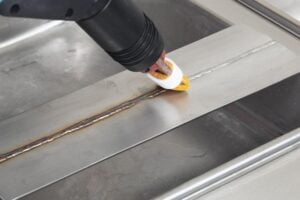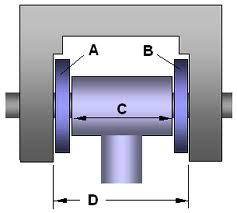What is Step Turning?
Step turning is a specific type of turning operation where a cylindrical workpiece is machined to have multiple sections with different diameters along its length, creating abrupt 90° transitions between these sections. These distinct diameter changes form a “stepped” profile, resembling a staircase. Unlike taper turning, which produces gradual diameter changes, step turning creates sharp, flat faces perpendicular to the axis of the workpiece. This method is essential for producing features such as bearing seats, gear shoulders, and mating surfaces that require precise, flat interfaces245.
How Step Turning Works: Step-by-Step Process?
The step turning process begins by securely mounting a cylindrical workpiece, typically a round or hollow bar, into the lathe chuck. The cutting tool, often a straight cutting or parting tool, is selected and mounted on the tool post. The lathe speed and feed are set according to material and tooling specifications.
The first step involves facing the end of the workpiece to create a flat reference surface. Next, the outer diameter is rough-cut to remove surface irregularities and mill scale, establishing a uniform starting diameter. The tool then moves parallel to the workpiece axis to machine each step sequentially, reducing the diameter to the required size for each section. Each step is finished with a precise cut to meet dimensional tolerances. The process concludes with a finishing pass to ensure surface quality and dimensional accuracy156.
Common Tools, Machines, and Materials Used in Step Turning
Step turning is typically performed on lathe machines, including manual engine lathes and CNC lathes, with CNC machines preferred for high precision and repeatability. The primary cutting tools used are straight cutting tools or parting tools made from high-speed steel (HSS), carbide, or ceramic materials, chosen based on the workpiece material.
Workpieces are commonly made from metals such as steel, aluminum, brass, and titanium, as well as plastics. The choice of material influences cutting parameters like speed, feed, and tool selection. CNC lathes equipped with advanced tool holders and coolant systems optimize the process for better surface finish and longer tool life146.
Technical Advantages and Challenges of Step Turning
Step turning offers several technical advantages. It enables the creation of complex parts with multiple diameters in a single setup, reducing production time and cost. The sharp 90° transitions provide precise functional interfaces necessary for components like bearings and gears. CNC step turning enhances repeatability and dimensional accuracy, minimizing human error.
However, challenges include managing tool wear due to abrupt diameter changes, ensuring proper tool alignment to avoid chatter or deflection, and achieving consistent surface finish on each step. The process requires skilled programming and setup, especially for complex multi-step parts. Material selection and cutting parameters must be optimized to prevent thermal damage or distortion126.
Step Turning Applications Across Industries
Step turning is widely used in industries requiring precision cylindrical components with multiple diameters. In automotive manufacturing, it produces shafts, axles, and transmission components with stepped sections for bearings and gears. Aerospace applications include turbine shafts, landing gear parts, and structural fasteners, where accuracy and reliability are critical.
Medical device manufacturing utilizes step turning for components like surgical instruments and implant parts that demand tight tolerances. Other sectors such as oil and gas rely on step turning for producing valves, connectors, and other complex cylindrical parts. The ability to machine multiple diameters in one operation improves efficiency and reduces lead times across these industries67.
Comparison: Step Turning vs. Taper Turning and Other Methods
Step turning and taper turning are both lathe operations but differ in geometry and tool movement. Step turning produces distinct cylindrical sections with abrupt diameter changes at right angles, while taper turning creates a gradual conical surface with a continuous diameter change along the length.
| Feature | Step Turning | Taper Turning |
|---|---|---|
| Diameter Change | Abrupt, 90° steps | Gradual, angled taper |
| Tool Movement | Parallel to workpiece axis | At an angle to workpiece axis |
| Surface Geometry | Flat, stepped surfaces | Sloped, tapered surfaces |
| Typical Applications | Bearing seats, shoulders, mating surfaces | Tapered shafts, cones, fits |
| Complexity | Simpler tool path, multiple diameters | Requires precise angle control |
Step turning is preferred for parts needing precise shoulders or seats, while taper turning suits applications requiring conical fits or gradual diameter changes235.
Surface Finish, Precision, and Quality Considerations
Achieving high surface finish and precision in step turning depends on tool sharpness, cutting parameters, and machine stability. Finishing passes with reduced feed rates and speeds improve surface smoothness. Proper tool geometry minimizes chatter and tool marks.
Dimensional tolerances are critical, especially at step transitions, where sharp edges must meet design specifications. CNC programming ensures consistent step lengths and diameters. Coolant application reduces heat buildup, preserving material properties and surface integrity. Quality control includes in-process measurement and post-machining inspection using micrometers, calipers, and coordinate measuring machines (CMM)167.
How to Choose the Right Supplier for Step Turning?
Selecting a supplier for step turning involves evaluating their equipment capabilities, technical expertise, and cost-effectiveness. The supplier should have modern CNC lathes with multi-axis control and advanced tooling options to handle complex step profiles.
Experience in machining similar materials and parts is essential to ensure quality and on-time delivery. Suppliers offering engineering support, prototyping, and process optimization add value. Transparent pricing and the ability to scale production volumes are also important factors67.
Key Factors in Supplier Evaluation: Equipment, Expertise, and Cost
When evaluating suppliers for step turning services, consider:
- Equipment: Availability of CNC lathes with appropriate size, precision, and tooling capabilities.
- Expertise: Skilled machinists and engineers familiar with step turning processes and quality standards.
- Cost: Competitive pricing balanced with quality assurance and delivery timelines.
- Support Services: CAD/CAM programming, process consultation, and quality control systems.
- Certifications: Compliance with industry standards such as ISO for quality management.
A supplier excelling in these areas ensures reliable production of complex step-turned parts67.
Case Studies: Step Turning Solutions
In automotive manufacturing, a supplier used CNC step turning to produce transmission shafts with multiple stepped diameters, improving assembly fit and reducing machining time by 30%. In aerospace, step turning was applied to turbine shafts requiring precise bearing seats, achieving tight tolerances and enhancing component lifespan.
Medical device manufacturers benefited from step turning to create surgical instrument shafts with complex stepped profiles, ensuring ergonomic and functional design. These cases demonstrate how step turning optimizes production efficiency and part quality across industries67.
How Suppliers Support Process Optimization (CAM, Consultation, etc.)?
Modern suppliers leverage CAM software to program step turning operations with high precision, simulating tool paths to avoid collisions and optimize cutting parameters. Consultation services help clients refine part designs for manufacturability and cost reduction.
Process optimization includes selecting optimal tooling, adjusting feeds and speeds, and implementing in-process monitoring to detect deviations early. Suppliers may also offer prototyping and iterative testing to perfect step turning processes before full-scale production67.
Conclusion and Takeaways
Step turning is a vital machining process for producing cylindrical parts with multiple diameters and sharp transitions. Its industrial relevance spans automotive, aerospace, medical, and other sectors requiring precision and efficiency. The process involves sequentially machining distinct diameter sections on a rotating workpiece using lathe machines and specialized cutting tools.
Advantages include reduced production time, enhanced accuracy, and the ability to create complex geometries in a single setup. Challenges such as tool wear and process control require skilled operation and advanced equipment. Selecting the right supplier with modern CNC capabilities, expertise, and support services is crucial for successful step turning projects.
Overall, step turning remains a cornerstone technique in precision manufacturing, enabling the production of high-quality, functional components with stepped profiles1267.
Frequently Asked Questions (FAQs)
What materials can be used in step turning?
Common materials include steel, aluminum, brass, titanium, and plastics, selected based on application requirements and machinability14.
Is step turning suitable for high-volume production?
Yes, especially when performed on CNC lathes, step turning offers repeatability and efficiency ideal for large batches7.
How does step turning differ from taper turning?
Step turning creates sharp, flat diameter changes at right angles, while taper turning produces gradual conical surfaces23.
What industries commonly use step turning?
Automotive, aerospace, medical, oil and gas, and general manufacturing industries frequently use step turning for precision components67.
What quality controls are used in step turning?
Dimensional inspections with micrometers, calipers, and CMMs ensure tolerances and surface finish meet specifications17.



